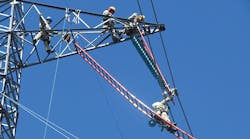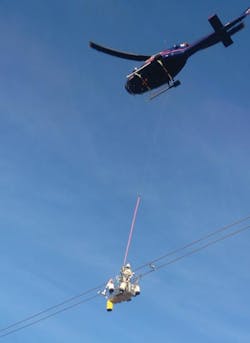Through live-line work, which originated in the early 1900s, linemen are maintaining, constructing or testing equipment and circuits that are energized or may become energized. Over the decades, utilities have fine-tuned work methods ranging from rubber gloving with cover up to 25 kV, using insulated tools from a minimum approach distance, or working barehand from a ladder, rope access, bucket truck, cart or helicopter.
While field crews can work on a de-energized line, the system is never truly de-energized because of induction or the risk of accidental energization. Many utilities still try to shut off power to equipment and power lines whenever possible, but some companies are boosting productivity through live-line work.
For example, Manitoba Hydro, based in Manitoba, Canada, discovered that it is possible to work on energized apparatus and transmission lines safely and efficiently. By developing appropriate procedures for energized and de-energized work and providing training with specialized live-line tools, linemen are able to facilitate maintenance of transmission lines.
As a result, linemen can keep power flowing while critical power is being performed, avoid revenue losses, maintain grid reliability and stability, and reduce congestion costs and impacts. In addition, this work method can be used when a storm knocks out power and crews must restore power quickly. Also, it can help to avoid scheduled outages, which are difficult to obtain and can be canceled on short notice. Finally, it can avoid risk due to human operating errors.
At the same time, however, live-line work carries a certain amount of risk. The risk to workers performing live-line work, however, is actually lower than the risk during de-energized work because workers are often unable to identify electrical sources. As a result, linemen are much more aware of hazards and are more cautious when performing live-line work. As a result, industry accidents and fatalities, as well, are much more common while working on de-energized lines.
To prevent incidents during live-line work, workers and supervisors require extensive specialized training, qualification and internal utility certification. Also, a considerably greater amount of research and testing has been performed to ensure safety during live-line work.
Conducting an Investigation
In 1997 and 2002, two hot stick flashovers under steady-state conditions halted live-line work at Manitoba Hydro on 500-kV AC/DC and 230-kV dead-ends. Through investigation, the utility attributed the 1997 flashover to the surface condition of the hot stick, to which weather conditions contributed. In 2002, the surface of the hot stick was in much better condition, and Manitoba Hydro discovered the role of salt contamination in the accidents.
For example, Manitoba Hydro discovered the main culprit of the flashover accidents was salt contamination from the workers’ gloves. For a flashover to occur, there must also be moisture, either from environmental conditions or from the gloves.
To determine salt was the cause of contamination, Manitoba Hydro replicated the flashover in a laboratory environment under similar conditions to the accidents. Specifically, the researchers tested the effect of light salt contamination with freezing conditions on the possibility of flashovers.
Through its research, Manitoba Hydro discovered that leakage or pollution distance can become more critical than arcing distance, which is the minimum approach distance based on switching surges. Also, utilities must not only consider the surface conditions of tools but also tool-handling procedures and environmental conditions. Up to this point, switching surges, combined with light pollution, have yet to be considered by the industry. How the hot sticks are stored is also critical to ensure the tools do not pass through the dew point and form condensation or icing. Going forward, Manitoba Hydro will continue to study performance of the hot sticks under freezing conditions, as temperatures in Manitoba can dip well below freezing.
Manitoba Hydro’s flashovers in 1997 and 2002, under freezing conditions, demonstrate the greater threat to live-line worker safety comes not from the small probability of switching surge overvoltage (for which the hot-stick lengths are determined) but from the more likely possibility of inadvertent contamination at levels so light as to be unnoticed during normal work. That is, leakage distance can become more critical than arcing distance.
Returning to Live-Line Work
Eleven years after the flashovers, Manitoba Hydro created a back-to-work strategy following years of investigation, research and testing. After the 1997 incident, the recommendations focused on improving the surface condition of the FRP hot sticks through rigorous annual testing and maintenance. Then, following the 2002 incident, the clean-fog tests identified critical contamination levels that are now being addressed by Manitoba Hydro through rigorous stick hygiene protocols. The cold-weather tests recently completed at cold-weather laboratories are addressing the utility’s field conditions and are expected to yield new lines of defense for live-line work in freezing conditions.
When changing its work practices, Manitoba Hydro realized that existing standards provide little to no guidance on surface conditions of tools. For example, according to current standards, utilities must maintain the insulating section of live working tools so that contamination does not compromise their electrical or mechanical integrity, and the insulation must not have a continuous film of moisture on the surface.
The current live-line standards specify the FRP hot sticks must be maintained in a clean condition, but they give no guidance on “how clean is clean.” Furthermore, IEEE Standard 516 states the minimum insulated tool lengths are based on standard atmospheric conditions, which means that the ambient temperatures are above freezing. It also states that “outside of standard atmospheric conditions, extra care must be taken.” The level of contamination that was found on the accident sticks, however, could not be seen by the naked eye.
Changing Work Practices
To ensure that the hot sticks are clean, free of contamination and in good working order, Manitoba Hydro now has a stick testing facility that can provide annual electrical testing and refinishing. In addition, the linemen can undertake weekly field testing of their hot sticks to avoid flashovers. Also, the utility has set wind and humidity restrictions for when live-line work can be performed and requires the use of flame-retardant clothing, full conductive suits and clean “stick gloves” for additional layers of protection. Workers also will wear clean coveralls while performing live-line work.
As part of its return-to-work plan, Manitoba Hydro is now focusing on hygiene with a new stick handling procedure and emphasizing the use of clean stick gloves. The hot stick is essentially being treated as a surgical tool. In addition, the utility is retraining its live-line workforce on 500-kV AC/DC and 230-kV dead-end tasks and requiring more on-site supervision from supervisors and live-line procedures staff members.
Along with these new procedural changes, the company also constructed three polymer sheds on 500-kV AC/DC hot sticks, which serve as markers and for electrical benefits. Sheds will be installed on hot sticks for all voltage levels. At Manitoba Hydro, the new limits of approach also must meet or exceed industry standards.
Manitoba Hydro has resumed live-line work practices at 500-kV AC/DC and 230-kV dead-ends now that it has implemented a back-to-work plan, conducted extensive investigations and changed worker policies. Case in point: linemen were able to work energized on the recent spacer damper replacement project on its 500-kV HVDC lines. By working live, Manitoba Hydro avoided taking outages, impacting the reliability of the system and incurring significant costs in lost export sales. As a result, the utility is able to meet customer demands by performing live-line work.
Jeff Laninga is a live-line procedures engineer for the live-line procedures, transmission line maintenance south department, Manitoba Hydro in Winnipeg, Manitoba, Canada. He is a professional engineer.




